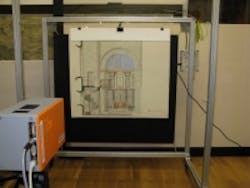Researchers use infrared camera to date Rembrandt sketches
A team of researchers at the Fraunhofer Institute for Wood Research, Wilhelm-Klauditz-Institut, WKI, have developed a method to use an infrared camera to determine precise dating of Rembrandt art sketches.
The findings of the research are the result of a collaboration with colleagues at the Herzog-Anton-Ulrich-Museum and the Institute for Communications Technology at the Technical University of Braunschweig (Germany). In the research, an infrared camera was used to scan the papers containing what was assumed to be sketches from Rembrandt. When imaging the sketches, the team is searching for a watermark, which provides information about the time period in which the paper and the artwork was produced.
Though the article does not specifically mention a model, the camera shown in the image appears to be an EQUUS 327k SM from IRCAM. This infrared camera features a 640 x 512 Mercury Cadmium Telluride infrared detector with a 15 µm pixel pitch and has a spectral range of 1.5 to 5 µm.
"We didn’t scan the papers with visible light, but instead used infrared light, or thermal radiation," says researcher Peter Meinlschmidt at the WKI. "The frequently used iron gall ink is transparent under this light. This means you see only the watermark without the ink or paint getting in the way."
The researchers look for deviations in thermal radiation of the sketches, with the camera being able to spot temperature differences of 15 millikelvin – just fifteen thousandths of a degree Celsius. In order to do this, the researchers clamp the paper in a passe-partout, which is positioned between an infrared heater and the camera. Heat must be evenly distributed, so the paper is kept a suitable distance from the heat source. While the heat is harmless to the paper, speed is of the essence, as the watermark is visible only for a few seconds due to the fact that the longer the paper is exposed to the heat source, the more intensely the ink-darkened areas heat up, which interferes with the temperature variations brought about by the watermark.
The infrared camera is then able to examine the watermark and locate the same image in a database. This work is currently done manually, but Meinlschmid suggests that the classification will soon be done using search algorithms. Using this method, the team has been able to date around 60 sketches associated with Rembrandt.
The infrared cameras currently being used by the researchers are cost prohibitive, so the team is working with the Saxon State and University Library in Dresden, Germany to lower the system’s price from about 80,000 euros to about 20,000-30,000 euros. The team will use an infrared camera with a resolution of about 50 millikelvin, as opposed to 15 millikelvin.
"We plan to compensate for the lower resolution through better image processing; for instance through the use of Gaussian filters, which remove noise, or differential images, which eliminate inconsistencies in the paper," Meinlschmidt said.
The first version of the software is currently being tested at the Saxon State Library using historic manuscript pages, and the system should be ready for use in two to three years, according to Fraunhofer.
View the Fraunhofer article.
Share your vision-related news by contacting James Carroll, Senior Web Editor, Vision Systems Design
To receive news like this in your inbox, click here.
Share your comments, tips, or questions in our comments section below.
Join our LinkedIn group | Like us on Facebook | Follow us on Twitter
About the Author

James Carroll
Former VSD Editor James Carroll joined the team 2013. Carroll covered machine vision and imaging from numerous angles, including application stories, industry news, market updates, and new products. In addition to writing and editing articles, Carroll managed the Innovators Awards program and webcasts.
